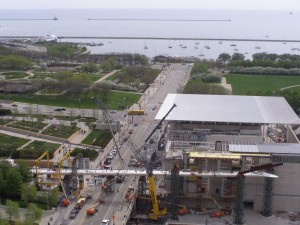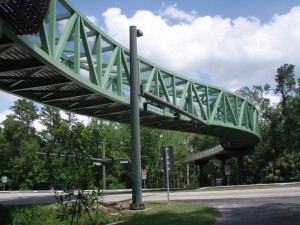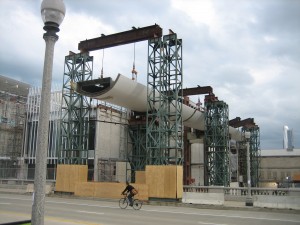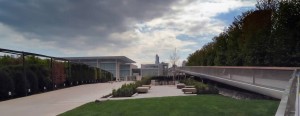Architects, engineers and fabricators have asked whether tubing can be formed with both camber and sweep. The answer is yes.
An example of tube bending that induces both camber and sweep can be seen in the sinuous pedestrian bridge in Longview, Florida, shown below. 66 tons of 14in square tube with a wall thickness of 5/8in was curved to a 139ft-8in radius to the following lengths with the corresponding camber: 2 pieces 55.8ft long with a 9/16in camber, 2 pieces 49.3 ft long with a 7/16in camber, 2 pieces 60.2ft long with a 5/8 camber, and 2 pieces 49.3ft long with a 5/8 camber.
Curved plate can also be fabricated with camber. A pedestrian bridge in Chicago linking Millennium Park to the Art Institute of Chicago is an example. 210 tons of 3/8, ½, and 5/8in plate rolled to a 10ft radius forms the bottom of this 620ft long bridge. Designed by architect Renzo Piano, the bridge was fabricated with a 20,000ft radius camber creating a 2.4ft mid-ordinate rise.

Structural steel can be formed into compound bends (bends in two planes), multi-radius bends, helical bends, minimum radius bends, and off-axis bends. Architects aware of these capabilities are increasingly incorporating this special bending in their designs to achieve special structural and aesthetic goals.











One comment on “Both Camber and Sweep in Tube Bending?”
Joe
July 1, 2011 at 7:12 pmRegarding tube bending with camber and sweep, I am currently working on curving 6in square tubing with a 3/16 wall that will become a barrier on the curved ramps at each end of the Brooklyn Bridge.
The barriers occur where the slightly convex or arched shape of the road meets the circular ramps. To match these curves, I am bending the tubing in two planes: the tubing will be curved in both plan and elevation.
For example, some tubing is curved so that the mid-ordinate rise over 26ft is sometimes as great as 3in. That’s 333ft radius.
On the other hand, I do have some 36ft long tubing bent in two planes where the rise is only 3/4in. The radius here would be about 2600ft.
I have found it difficult to define where a bend radius in elevation stops becoming a camber and becomes a smaller radius. Some people say that a camber would have to have at least a 250ft radius.